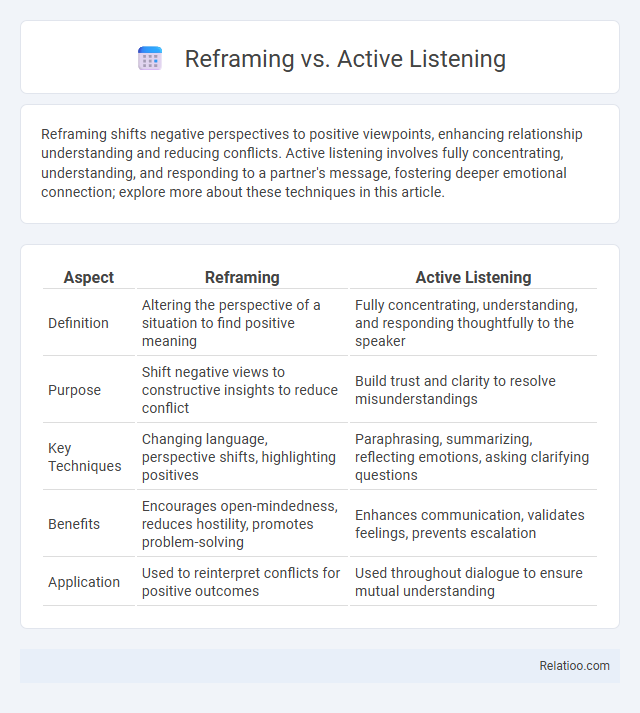Reframing shifts negative perspectives to positive viewpoints, enhancing relationship understanding and reducing conflicts. Active listening involves fully concentrating, understanding, and responding to a partner's message, fostering deeper emotional connection; explore more about these techniques in this article.
Table of Comparison
| Aspect | Reframing | Active Listening |
|---|---|---|
| Definition | Altering the perspective of a situation to find positive meaning | Fully concentrating, understanding, and responding thoughtfully to the speaker |
| Purpose | Shift negative views to constructive insights to reduce conflict | Build trust and clarity to resolve misunderstandings |
| Key Techniques | Changing language, perspective shifts, highlighting positives | Paraphrasing, summarizing, reflecting emotions, asking clarifying questions |
| Benefits | Encourages open-mindedness, reduces hostility, promotes problem-solving | Enhances communication, validates feelings, prevents escalation |
| Application | Used to reinterpret conflicts for positive outcomes | Used throughout dialogue to ensure mutual understanding |
Introduction to Reframing and Active Listening
Reframing involves shifting the perspective on a situation to alter its meaning, promoting positive thinking and problem-solving. Active listening requires fully concentrating, understanding, and responding thoughtfully to the speaker, enhancing communication and empathy. Both techniques improve interpersonal interactions by fostering clarity and emotional connection.
Defining Reframing in Communication
Reframing in communication involves changing the perspective of a message to alter its meaning and emotional impact, helping individuals see situations in a more positive or constructive light. Unlike active listening, which centers on attentively understanding and responding to the speaker's message, reframing shifts the context or interpretation to promote clarity and resolve conflicts. Effective reframing enhances communication by fostering empathy, reducing misunderstandings, and encouraging collaborative problem-solving.
What is Active Listening?
Active listening is a communication technique that requires fully concentrating, understanding, and responding thoughtfully to the speaker, enhancing meaningful dialogue. Unlike reframing, which involves changing the perspective or interpretation of a statement, active listening prioritizes empathy and validation by acknowledging feelings and paraphrasing content. Your ability to practice active listening strengthens relationships by fostering trust and reducing misunderstandings during conversations.
Key Differences Between Reframing and Active Listening
Reframing involves changing the perspective on a situation to alter its meaning, while active listening focuses on fully understanding and reflecting the speaker's message without judgment. You enhance communication by using reframing to shift negative thoughts into positive interpretations, whereas active listening builds trust and clarity by attentively acknowledging and validating the speaker's emotions. Key differences include reframing's goal of cognitive change versus active listening's emphasis on empathetic engagement and comprehension.
Psychological Benefits of Reframing
Reframing transforms negative thought patterns by altering your interpretation of stressful events, leading to improved emotional resilience and reduced anxiety. Unlike active listening, which primarily enhances communication and empathy, reframing directly targets cognitive restructuring to promote positive mental health. You can experience increased self-awareness and greater psychological flexibility by consistently practicing reframing techniques in everyday challenges.
The Role of Empathy in Active Listening
Empathy plays a crucial role in active listening by allowing you to fully understand and connect with the speaker's emotions and perspectives, enhancing communication effectiveness. Unlike reframing, which involves changing the interpretation of a message, active listening emphasizes emotional validation and presence without judgment. Your ability to empathize fosters trust and opens pathways for clearer, more meaningful dialogues.
When to Use Reframing in Conversations
When to use reframing in conversations is primarily when a perspective shift is needed to reduce negativity or conflict, helping individuals see situations in a more positive or constructive light. Reframing is effective during moments of misunderstanding, emotional distress, or fixed mindsets where alternative viewpoints can facilitate problem-solving or emotional relief. Unlike active listening, which focuses on empathetic understanding and validation, reframing actively transforms perceptions, making it ideal for coaching, counseling, or conflict resolution scenarios.
Techniques for Effective Active Listening
Active listening techniques include maintaining eye contact, nodding to show understanding, and paraphrasing the speaker's message to confirm comprehension. Reframing involves restating negative or ambiguous statements in a positive or neutral light to alter perception and promote constructive dialogue. Combining these methods enhances communication by fostering empathy, clarity, and collaborative problem-solving.
Reframing and Active Listening in Conflict Resolution
Reframing shifts negative or unproductive perspectives into more positive or constructive viewpoints, which helps reduce defensiveness and opens pathways for collaboration during conflict resolution. Active listening involves fully concentrating, understanding, and responding empathetically to the speaker, fostering trust and minimizing misunderstandings in tense conversations. Both techniques complement each other by promoting clarity and emotional safety, thereby facilitating effective conflict de-escalation and mutual problem-solving.
Developing Skills: Combining Reframing and Active Listening
Combining reframing and active listening enhances your communication skills by allowing you to understand conversations deeply while shifting perspectives to foster positive outcomes. Active listening involves fully concentrating, understanding, and responding to the speaker, whereas reframing changes the context or interpretation of a message to create new meaning. Developing these skills together improves empathy, conflict resolution, and problem-solving in personal and professional interactions.

Infographic: Reframing vs Active Listening
 relatioo.com
relatioo.com